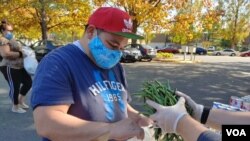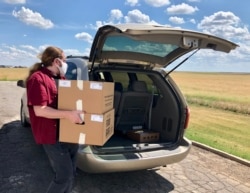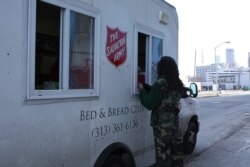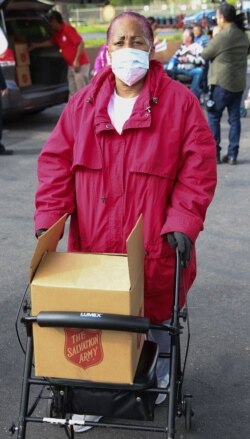Food assistance has skyrocketed since the coronavirus pandemic began in the United States 10 months ago.
Job losses, reduced wages, business closures and illness from COVID-19, the disease caused by the coronavirus, are taking their toll on millions of Americans who are concerned about not having enough food to feed their families.
As the coronavirus has surged, people from Anchorage, Alaska, to Atlanta, Georgia, are going to food banks and food distribution centers to pick up free groceries.
In cities and rural areas, “there is stress on all the food banks because of the large amount of people requesting food,” said Zack Wilson, executive director of the High Plains Food Bank in Amarillo, Texas.
“The pandemic has increased the demand for food assistance in communities that were already struggling, especially for people of color and low-income working families,” said Kyle Waide, CEO of the Atlanta Community Food Bank, one of the largest food banks in the nation.
“Half the people who come to our food pantry are there for the first time,” which also includes middle-class Americans without jobs, Waide said.
“Across the country, we’re seeing about a 60% increase in the number of people going to food banks,” said Zuani Villarreal, communications director for Feeding America, a nationwide network of more than 200 food banks.
“There are a lot of people who are barely making ends meet, and they need a little extra help to put food on the table,” Villarreal said. “Food banks are scrambling to meet the increasing demand for donations of food.”
“The food banks are doing the best they can,” said Luis Guardia, president of the Food Research and Action Center. “But the system is not designed to feed so many people.”
In Atlanta, there has been “a 70% increase in the amount of food we’re providing,” Waide said. With help from the government and private donors, such as farmers and grocery stores, he said the food bank had been able to meet the need so far.
Mike Miller, president of the River Bend Foodbank in Davenport, Iowa, said food insecurity in his area “is at the highest level it’s ever been.”
He said the group usually gets donations from grocery stores. But because of some food shortages, the food bank is instead purchasing supplies from wholesalers and manufacturers. This increases our costs, and it takes longer for the food to arrive, making it more difficult to get it to people who need it the most, Miller said.
Jamie Winkler, an executive director with the Salvation Army in Detroit, Michigan, said it has been “overwhelming” how many people need food in the low-income neighborhoods of a city that is already challenged by urban decay and poverty.
“A lot of people lost their jobs, and some of them became homeless,” he said. “And families are finding it difficult to feed their children, since they can’t get free meals at school anymore because they are closed due to the pandemic.”
Winkler said the Salvation Army drives “bread trucks” around the low-income neighborhoods offering soup, sandwiches and hot meals.
Other food distribution centers are also finding it crucial to bring supplies to where people live, especially in rural and remote areas.
Wilson, with the High Plains Food Bank in Amarillo, said his group can get food to people in the city. But the rural area outside Amarillo is more challenging because the average distance between towns is 48 kilometers, he said.
For protection from the coronavirus, he said the food bank is operating a contactless mobile food pantry, where food boxes are loaded into vehicles.
Wilson said his group is particularly concerned about the seniors living in rural communities because many of them live alone.
Alaska has been hit hard by the need for food, especially since the state has had fewer visitors during the pandemic.
“Tourism is a huge part of our economy,” said Cara Durr, director of public engagement at the Food Bank of Alaska in Anchorage. “Cruise ships were canceled, and many people didn’t come for vacation.”
She said the only way to get food to the remote parts of the huge state is by air.
“We are the only food bank in the country that delivers food by plane. Some native villages may have just a couple hundred people, and it’s challenging and expensive to get food to them,” she said.
In Alexandria, Virginia, Yolanda Thompson has set up a small food pantry in front of her home. Once a week, she gives food to some low-income neighbors who have lost their jobs or had their hours cut. With the help of family, friends and a local nonprofit, she buys and hands out groceries such as fresh vegetables, flour and rice.
Mirna Nolasco, who arrived at Thompson’s house with her baby, said the additional food is “a blessing to my family.”









